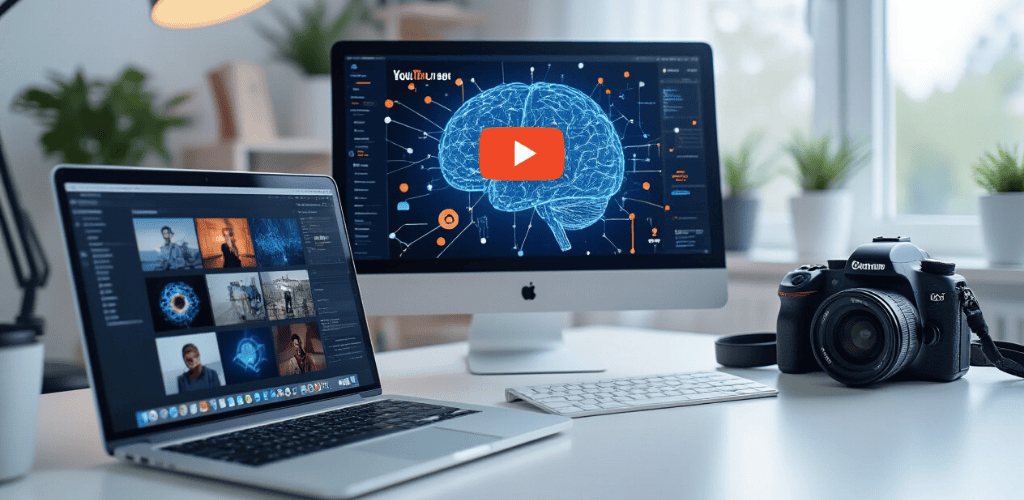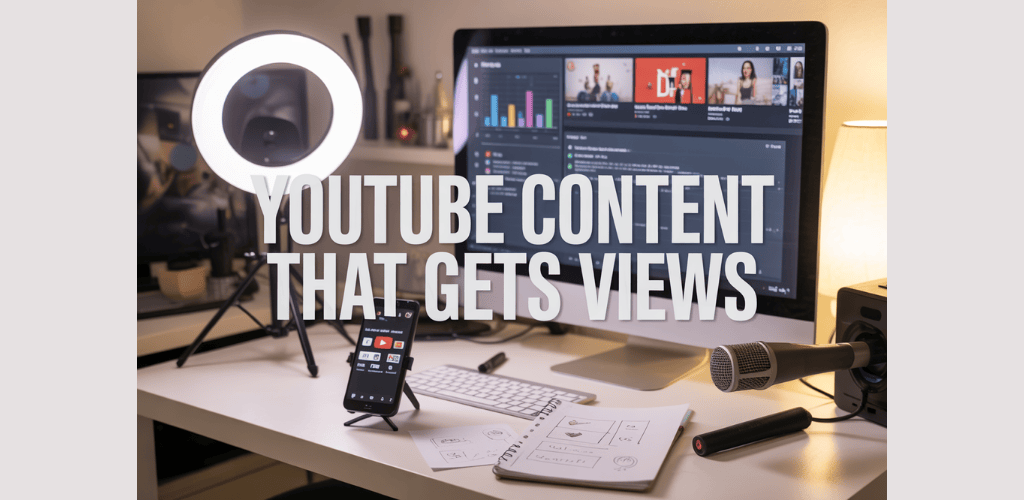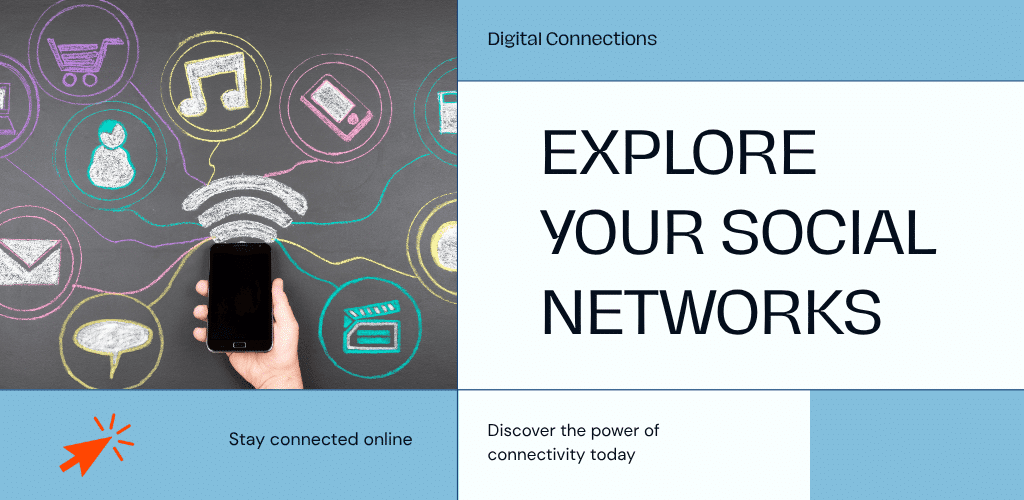Getting views on YouTube feels impossible when you’re starting out, but the right content strategy changes everything. This guide is for creators who want to move beyond posting random videos and start building an audience that actually watches and engages.
YouTube’s algorithm rewards creators who understand what their viewers want and deliver it consistently. The difference between channels that struggle and those that grow comes down to using data, diversifying content formats, and knowing how to work with YouTube’s recommendation system instead of against it.
We’ll cover how to use analytics to drive your content strategy so you’re making videos people actually search for. You’ll also learn how to diversify your content format to reach more viewers through everything from long-form videos to YouTube Shorts. Plus, we’ll explore collaboration strategies that help you tap into new audiences and grow faster than going it alone.
Table of Contents
Use Analytics to Drive Content Strategy

Understanding your audience through data is the foundation of successful YouTube content creation. YouTube’s analytics platform provides creators with invaluable insights that can transform your content strategy from guesswork into a data-driven approach that consistently delivers results.
Analyze Viewer Behavior and Watching Habits
Getting to know your audience through data is essential for creating content that resonates. YouTube analytics reveals crucial patterns about when your viewers are most active, how they discover your videos, and what keeps them engaged. By examining audience retention graphs, you can identify exactly where viewers tend to drop off and what moments capture their attention most effectively.
Demographics data shows you the age ranges, geographic locations, and interests of your core audience, allowing you to tailor your content language, references, and topics accordingly. Traffic source analytics reveal whether your viewers find you through search, suggested videos, or external platforms, informing your optimization strategy for each discovery method.
Viewing session data helps you understand whether your content encourages binge-watching or standalone consumption, which directly impacts how you should structure your video series and calls-to-action. This behavioral analysis forms the backbone of strategic content planning that aligns with actual viewer preferences rather than assumptions.
Identify High-Performing Video Types and Optimal Lengths
Advanced Mode analytics provides deeper insights into content performance trends, revealing which video formats generate the most engagement and retention. By analyzing your top-performing videos, you can identify common elements such as thumbnail styles, title structures, and content approaches that consistently drive views and engagement.
Video length optimization becomes clear through retention analytics, showing you the sweet spot for your specific audience and content type. Some channels thrive with longer, in-depth content, while others perform better with concise, focused videos. The data will reveal what video length works best for your channel’s unique audience and niche.
Content type analysis helps you understand whether tutorials, entertainment, reviews, or other formats perform better for your channel. This insight allows you to focus your efforts on creating more of what your audience actively seeks and engages with, rather than spreading resources across content types that underperform.
Spot Monetization Opportunities Through Data Insights
Analytics reveal untapped revenue potential by highlighting which videos and content types generate the highest engagement rates and watch time. Videos with strong performance metrics often indicate topics or formats that could support premium content, sponsorships, or product placements.
Audience engagement patterns show which videos spark the most comments, likes, and shares, indicating content that builds stronger community connections and brand loyalty. These high-engagement videos often present opportunities for merchandise promotion, channel memberships, or super chat monetization during live streams.
Geographic and demographic data can reveal potential markets for region-specific content or products, opening doors to targeted sponsorship opportunities or localized content creation that commands higher advertising rates.
Track Impressions and Recommendation Factors
Understanding the factors that influence your video impressions is crucial for maximizing reach through YouTube’s recommendation system. Analytics show how your thumbnails and titles perform in terms of click-through rates, helping you optimize these critical first-impression elements.
Impression analytics reveal whether your content is being discovered through search, browse features, or suggested videos, allowing you to optimize for each traffic source appropriately. Videos that perform well in suggested videos require different optimization strategies than those that excel in search results.
Traffic analytics are particularly useful for understanding sudden increases in viewership, such as those pointing to YouTube Shorts performance. When you notice spikes in traffic or impressions, diving into the data helps you understand what triggered the algorithm’s increased promotion, allowing you to replicate those successful elements in future content.
Diversify Your Content Format to Reach More Viewers

Now that we have covered analytics-driven content strategy, let’s explore how diversifying your YouTube content formats can significantly expand your reach and attract different audience segments. The key to sustainable YouTube growth lies in understanding that your viewers consume content in various ways across different devices and situations.
Create YouTube Shorts for Mobile-First Audiences
YouTube Shorts represents one of the most powerful opportunities for creators to tap into mobile-first audiences who prioritize quick, easily digestible content. This format is specifically designed for viewers who prefer consuming content on their phones, making it essential for your YouTube content strategy.
The beauty of YouTube Shorts lies in its accessibility and convenience. Viewers can effortlessly scroll through multiple Shorts in a single session, creating an addictive viewing experience that keeps them engaged with your channel longer. The sharing mechanism is also streamlined for mobile users, allowing them to quickly distribute your content across social platforms directly from their phones.
For creators focused on how to get views on YouTube, Shorts offer an unparalleled opportunity to reach audiences who might never have discovered your long-form content. The format’s algorithm tends to surface content more aggressively, giving newer creators a fighting chance to compete with established channels.
How to Make Content on Youtube Shorts
Creating effective YouTube Shorts requires a mobile-first mindset from conception to execution. The shooting process is intentionally simplified, allowing you to create compelling content using nothing more than your smartphone. This accessibility removes traditional barriers to content creation while maintaining professional quality standards.
When developing your YouTube Shorts creation process, focus on vertical video orientation and quick, attention-grabbing openings. The format rewards creators who can deliver value or entertainment within the first few seconds, making concise storytelling absolutely crucial for success.
Consider repurposing highlights from your longer videos into Shorts format, creating multiple touchpoints for potential viewers to discover your channel. This approach maximizes your content investment while serving different viewing preferences within your audience.
Use Live Streaming to Build Real-Time Connections
With this in mind, next, we’ll explore how YouTube Live transforms the creator-audience relationship through meaningful real-time interactions. Live streaming enables a level of connection that pre-recorded content simply cannot match, fostering genuine community building around your channel.
The interactive nature of live streaming allows viewers to influence your content in real-time through comments, questions, and suggestions. This two-way communication creates a sense of participation that makes viewers feel valued and heard, significantly increasing their likelihood to return and engage with future content.
You have multiple options for broadcasting, whether through your phone for casual, on-the-go streams, webcam for desktop-based content, or professional encoder setups for high-production value broadcasts. This flexibility means you can integrate live streaming into your YouTube content creation workflow regardless of your technical setup or budget constraints.
Experiment with Different Video Lengths and Styles
Previously, we’ve established that analytics provide crucial insights into optimal video length and content types that resonate most with your specific audience. This data should directly inform your experimentation with various formats and durations.
Your YouTube analytics reveal patterns about viewer retention, engagement peaks, and drop-off points across different video lengths. Use this information to test content ranging from quick tutorials and explanations to in-depth analyses and comprehensive guides. Each length serves different viewer intentions and consumption contexts.
Style experimentation goes beyond duration to include presentation methods, editing techniques, and narrative structures. Some viewers prefer straight-to-the-point instructional content, while others enjoy storytelling approaches or entertainment-focused presentations. Testing various styles helps you identify what resonates most effectively with your target audience while potentially attracting new viewer segments.
Keep Content Fresh to Attract New Audience Segments
Maintaining content freshness requires continuous innovation in your approach to familiar topics and regular introduction of entirely new subject matter. This strategy prevents your channel from becoming predictable while opening doors to previously untapped audience segments.
Fresh content doesn’t necessarily mean completely abandoning successful formats or topics. Instead, it involves finding new angles, updated information, or different presentation methods for subjects you’ve covered before. This approach satisfies returning viewers seeking new insights while making your content discoverable to audiences who might have different search behaviors or interests.
Regularly introducing new content categories or formats also signals to YouTube’s algorithm that your channel is active and evolving, potentially improving your visibility in search results and recommendations. This algorithmic benefit, combined with the expanded audience reach, makes content diversification a critical component of any successful YouTube content strategy.
Leverage Collaborations for Channel Growth

Now that we’ve covered the technical aspects of content strategy, let’s explore one of the most powerful yet underutilized methods for expanding your YouTube presence: strategic collaborations with other creators. Collaborations represent a fundamental shift from solo content creation to community-driven growth, offering unprecedented opportunities to amplify your reach and enhance your YouTube content creation skills.
Choose Strategic Collaboration Partners
The foundation of successful YouTube collaboration strategies lies in selecting the right partners who align with your channel’s vision and audience demographics. When identifying potential collaborators, focus on creators who share complementary skills and audience overlap without direct competition. Look for partners whose content quality matches or exceeds your standards, as their reputation will reflect on your channel’s credibility.
Strategic partner selection involves analyzing potential collaborators’ engagement rates, audience demographics, and content consistency. Creators with similar subscriber counts often provide the most balanced collaborative relationships, ensuring mutual benefit rather than one-sided promotion. Additionally, consider collaborating with creators in adjacent niches who can introduce fresh perspectives while maintaining relevance to your existing audience.
The timing of collaboration invitations matters significantly. Reach out to potential partners when both channels are experiencing growth phases, as this creates momentum that benefits both parties. Present clear collaboration proposals that outline mutual benefits, content concepts, and expected outcomes to demonstrate professionalism and serious intent.
Learn New Skills Through Creator Partnerships
Collaborations serve as intensive learning laboratories where creators can acquire new techniques and perspectives that enhance their individual YouTube content strategy. Working alongside experienced creators provides direct access to their creative processes, technical expertise, and audience engagement methods that would otherwise take months or years to develop independently.
Through creator partnerships, you can observe different approaches to video editing, storytelling techniques, and audience interaction styles. These collaborations expose you to new tools, software, and production methods that can elevate your content quality. Additionally, collaborative environments often spark creative solutions to common YouTube challenges, as different perspectives combine to generate innovative approaches.
The learning extends beyond technical skills to include strategic insights about how to get views on YouTube through different content formats and presentation styles. Collaborating creators often share their successful strategies for viral YouTube content, providing valuable intelligence that can be adapted to your unique channel identity.
Cross-Promote to Expand Your Fanbase
Cross-promotion through collaborations creates powerful synergies that exponentially increase your content’s reach beyond your existing subscriber base. When you collaborate with another creator, you’re essentially gaining access to their entire audience, many of whom may discover your channel for the first time through the collaborative content.
Effective cross-promotion involves creating content that provides genuine value to both audiences rather than simply featuring both creators. This approach ensures that new viewers from your collaborator’s channel have compelling reasons to subscribe and engage with your content long-term. The key is developing collaborative content that feels natural and authentic rather than forced promotional material.
Strategic cross-promotion extends beyond the initial collaborative video to include social media mentions, community posts, and follow-up content that maintains the connection between audiences. This sustained promotion helps convert initial viewers into dedicated subscribers who contribute to your long-term channel growth.
Maximize Collaborative Content Impact
To maximize the impact of your collaborative efforts, focus on creating content that leverages both creators’ unique strengths while appealing to combined audiences. This involves careful planning of content formats, themes, and distribution strategies that optimize visibility and engagement across both channels.
Successful collaborative content often performs better than individual videos because it combines the creative energy and established audiences of multiple creators. Plan collaborative sessions that allow for spontaneous interactions and authentic chemistry, as these elements often create the most engaging and shareable moments.
Consider creating series of collaborative content rather than one-off videos to maintain audience interest and provide multiple touchpoints for cross-pollination between fanbases. This extended collaboration approach builds stronger relationships with partner creators while providing more opportunities to demonstrate your value to new audiences.
Document and analyze the performance metrics of collaborative content to understand which collaboration styles and formats resonate most with your combined audiences. This data-driven approach helps refine future collaboration strategies and ensures continuous improvement in your YouTube collaboration strategies.
Master YouTube’s Discovery and Recommendation System

Understanding YouTube’s complex recommendation engine is crucial for creators who want to increase YouTube views and develop an effective YouTube content strategy. The platform’s algorithm determines which videos get discovered, making it essential to understand how this system operates and how to optimize your content accordingly.
Understand how YouTube makes video recommendations
YouTube’s recommendation system operates through sophisticated machine learning algorithms that analyze viewer behavior patterns, engagement metrics, and content signals. The platform evaluates how viewers interact with your content, including watch time, likes, comments, and shares, to determine which videos deserve broader distribution.
The algorithm considers multiple factors when making recommendations, including session duration, click-through rates, and audience retention. Videos that keep viewers on the platform longer and encourage them to watch additional content receive preferential treatment in the recommendation system. This means your YouTube video optimization efforts should focus on creating compelling content that naturally leads viewers to consume more videos within their session.
YouTube also analyzes the relationship between your content and viewer preferences. When users consistently engage with similar content types, the algorithm identifies patterns and suggests related videos. Understanding this connection helps you align your YouTube content creation with audience interests while staying within your niche’s broader ecosystem.
Optimize content for search visibility
Search optimization on YouTube requires understanding the science behind how the platform indexes and ranks content. Your video titles, descriptions, and tags serve as primary signals that help YouTube understand your content’s context and relevance to specific search queries.
Strategic keyword placement within your video metadata significantly impacts discoverability. However, successful YouTube algorithm tips extend beyond simple keyword stuffing. The platform prioritizes content that matches user intent, meaning your optimization efforts should focus on creating genuinely valuable content that addresses what viewers are actively searching for.
Thumbnail optimization plays a crucial role in search visibility, as compelling visual elements increase click-through rates from search results. Combined with engaging titles that incorporate relevant search terms naturally, these elements work together to improve your content’s performance in YouTube’s search results.
Study factors that influence video impressions
Video impressions are governed by multiple interconnected factors that determine how often your content appears in recommendations, search results, and suggested video feeds. The timing of your uploads, audience engagement patterns, and content freshness all influence impression volume.
YouTube evaluates content quality through audience retention metrics, measuring how long viewers stay engaged with your videos. Higher retention rates signal valuable content to the algorithm, resulting in increased impressions across the platform’s various discovery surfaces.
The platform also considers your channel’s overall performance history when determining impression distribution. Consistently creating engaging content builds algorithmic trust, leading to better impression rates for future uploads. This cumulative effect makes long-term YouTube content strategy planning essential for sustained growth.
Analyze why certain videos perform better than others
Performance analysis reveals that successful videos typically share common characteristics related to audience engagement and content structure. Videos that generate strong initial engagement signals within the first few hours after upload often receive enhanced algorithmic promotion.
Content length and format significantly impact performance, with different video durations performing better for different content types and audience preferences. Understanding your specific audience’s viewing patterns through YouTube analytics helps identify optimal content formats that maximize engagement and retention.
The relationship between content topics and audience interest fluctuations also affects performance. Videos that align with trending topics or address timely audience needs often experience higher engagement rates, leading to improved algorithmic distribution and increased overall reach.
Strategically Pivot Your Content When Necessary

Now that we have covered the technical aspects of YouTube’s algorithm and analytics, it’s crucial to understand that even the most successful channels sometimes need to evolve. Strategic content pivoting represents one of the most challenging yet essential skills for long-term YouTube success. The platform’s dynamic nature, changing audience preferences, and evolving trends demand that creators remain flexible in their approach to YouTube content creation.
Recognize When Content Changes Are Needed
The first step in executing a successful pivot involves recognizing the warning signs that indicate your current YouTube content strategy may no longer be serving your channel effectively. Several key indicators should prompt you to consider a strategic shift in your content direction.
Performance metrics often provide the clearest signals that change is necessary. When you notice consistent declines in views, engagement rates, or subscriber growth over extended periods, these trends suggest your content may be losing relevance with your audience. Additionally, shifts in your niche or industry landscape can render your current content approach less effective than it once was.
Audience feedback serves as another critical indicator for potential pivots. Pay attention to comments requesting different types of content, decreased engagement on specific video formats, or shifts in your demographic data that suggest your audience is evolving in ways your content isn’t matching.
External factors also play a significant role in determining when pivots become necessary. Algorithm changes, new platform features, or broader cultural shifts can impact how your content performs, regardless of its inherent quality. Recognizing that sometimes a pivot in your channel’s content is necessary requires honest self-assessment and a willingness to acknowledge when your current approach isn’t generating the results you need for sustainable growth.
Plan Pivots to Maintain Audience Engagement
Strategic planning forms the foundation of successful content pivots that preserve your existing viewer base while attracting new audiences. The key to maintaining audience engagement during transitions lies in thoughtful preparation and gradual implementation rather than sudden, dramatic changes that might alienate your core viewers.
Begin by analyzing your most successful content to identify the underlying elements that resonated with your audience. These core components—whether they’re your presentation style, specific topics, or production quality—should be preserved throughout any pivot to maintain continuity with your established brand identity.
Plan pivots strategically to set yourself up for success by developing a transition timeline that allows for gradual shifts rather than abrupt changes. This approach enables you to test new content directions while maintaining elements that your audience expects from your channel. Consider introducing new content types as experimental series or special episodes before making them permanent fixtures of your channel.
Communication with your audience during pivot planning proves essential for maintaining engagement. Transparency about your evolving content direction, while not revealing every strategic detail, helps prepare your viewers for changes and can even generate excitement about new directions your channel might take.
Use Data to Guide Content Direction Changes
Data-driven decision making becomes particularly crucial when executing content pivots, as emotions and creative impulses can sometimes lead creators away from strategies that actually work for their specific audience and niche.
Your YouTube analytics provide invaluable insights into which content elements consistently perform well across different video types and topics. Examine patterns in your highest-performing videos to identify transferable elements that should be incorporated into new content directions. This includes analyzing optimal video lengths, posting schedules, thumbnail styles, and topic categories that generate the strongest viewer response.
Audience retention graphs offer specific insights into when viewers lose interest in your content, helping you understand what aspects of your current approach might need adjustment in your pivot strategy. Low retention rates at specific points in your videos can indicate structural issues that should be addressed regardless of content topic changes.
Comment analysis and community engagement data reveal audience preferences and interests that might not be immediately apparent from view counts alone. This qualitative data helps ensure that your pivot strategy aligns with actual viewer desires rather than assumptions about what your audience might want.
Execute Strategic Shifts Without Losing Core Viewers
The execution phase of content pivoting requires careful balance between innovation and consistency to prevent alienating your established viewer base while successfully transitioning to new content directions.
Gradual implementation serves as the most effective approach for retaining core viewers during strategic shifts. Rather than completely abandoning your previous content style overnight, introduce new elements progressively while maintaining familiar aspects that your audience has come to expect from your channel.
Maintain your unique voice and personality throughout any content pivot, as these personal elements often represent the primary reason viewers subscribe to specific channels. Your individual perspective and presentation style should remain consistent even as your topic focus or video format evolves.
Consider creating content bridges that connect your previous topics with new directions, helping your audience understand the logical progression of your channel’s evolution. These transitional videos can demonstrate how your new content serves the same underlying audience needs as your previous work, just through different approaches or topics.
Testing new content directions through limited series or special projects allows you to gauge audience response before committing fully to new directions. This approach provides valuable feedback while giving you the flexibility to adjust your strategy based on actual viewer response rather than assumptions about what might work.
How to Make Content on Youtube With Ai

Now that we’ve covered the foundational strategies for YouTube content creation, it’s time to explore how artificial intelligence can revolutionize your YouTube content strategy and help you create videos that attract more views. AI tools have become increasingly sophisticated, offering creators unprecedented opportunities to streamline their content production while maintaining quality and engagement.
AI-Powered Content Ideation and Research
The foundation of successful YouTube content creation begins with identifying topics that resonate with your audience. AI can analyze trending topics, search patterns, and competitor performance to suggest content ideas that align with current viewer interests. These intelligent systems can process vast amounts of data to identify content gaps in your niche and suggest video concepts that have high potential for views.
When developing your YouTube content strategy, AI tools can help you understand what type of content performs best in your specific category. By analyzing successful videos in your space, AI can identify patterns in titles, descriptions, thumbnails, and content structure that contribute to higher view counts. This data-driven approach to content planning removes much of the guesswork from YouTube video optimization.
Automated Script Writing and Content Structuring
Creating compelling scripts is crucial for maintaining viewer engagement throughout your videos. AI writing assistants can help structure your content in ways that align with how to get views on YouTube by following proven narrative frameworks. These tools can generate outlines, suggest talking points, and even create full scripts based on your topic and target audience.
The key advantage of using AI for script creation lies in its ability to incorporate YouTube algorithm tips directly into your content structure. AI can suggest optimal video lengths, recommend when to include calls-to-action, and advise on pacing to maximize viewer retention – all critical factors that influence how the YouTube algorithm promotes your content.
Enhanced Video Production Through AI Tools
Modern AI tools can significantly streamline your video production process. From automated video editing that can cut together highlights from longer recordings to AI-powered thumbnail generation that follows best practices for click-through rates, these technologies can help you create professional-quality content more efficiently.
Voice synthesis and text-to-speech technologies have also advanced to the point where they can create natural-sounding narration for explainer videos, tutorials, or documentary-style content. This is particularly valuable for creators who want to increase YouTube views by producing content consistently but may have limitations with on-camera presentation or voiceover recording.
AI-Driven Analytics and Performance Optimization
With this in mind, AI excels at processing and interpreting YouTube analytics for creators. Advanced AI analytics tools can identify patterns in your video performance that might not be immediately obvious, such as which segments of your videos tend to lose viewers or which topics generate the most engagement.
These insights enable you to refine your approach to YouTube content creation by understanding exactly what elements contribute to higher view counts and better engagement rates. AI can track performance across multiple variables simultaneously, providing recommendations for everything from optimal posting times to content format adjustments.
Personalization at Scale
Previously, creating personalized content for different audience segments required significant time and resources. AI now enables creators to customize thumbnails, titles, and even video content for different viewer demographics automatically. This level of personalization can significantly improve your content’s performance across diverse audience segments while maintaining efficiency in your production workflow.
The integration of AI into your YouTube content creation process represents a strategic advantage that can help you create more engaging, discoverable, and successful content while optimizing your time and resources for maximum impact on viewer growth.
FAQ’s
Now that we’ve covered the essential strategies for creating successful YouTube content, let’s address some of the most frequently asked questions that creators have when starting their YouTube content creation journey.
How much does a 1000 views pay on YouTube?
The earnings from 1,000 YouTube views can vary significantly depending on multiple factors. YouTube creators typically earn between $0.50 to $5.00 per 1,000 views through the YouTube Partner Program, but this range can fluctuate based on your audience demographics, content niche, and geographic location of your viewers.
Several key factors influence your YouTube earnings per 1,000 views:
- Audience Demographics: Viewers from countries with higher purchasing power typically generate more ad revenue
- Content Category: Some niches like finance, technology, and business attract higher-paying advertisements
- Engagement Rates: Videos with higher watch time, likes, and comments tend to perform better in YouTube’s algorithm, leading to more monetization opportunities
- Seasonal Trends: Ad rates can fluctuate throughout the year, with higher rates during holiday seasons
It’s important to note that ad revenue is just one monetization stream. Successful creators often diversify their income through sponsorships, merchandise, affiliate marketing, and channel memberships, which can significantly increase earnings beyond the basic ad revenue model.
How can I get 4000 hours on YouTube fast?
Reaching 4,000 hours of watch time is a crucial milestone for YouTube monetization eligibility. This requirement translates to 240,000 minutes of total watch time across your channel within a 12-month period. Here are proven strategies to accelerate your path to this goal:
Content Strategy Optimization:
- Create longer-form content (10-20 minutes) when appropriate for your niche, as this naturally increases watch time
- Develop series or multi-part videos that encourage binge-watching
- Focus on evergreen content that continues attracting views over time
- Optimize your YouTube video optimization by creating compelling thumbnails and titles that accurately represent your content
Audience Retention Techniques:
- Hook viewers within the first 15 seconds with a compelling preview of what’s coming
- Use pattern interrupts and visual changes every 30-60 seconds to maintain attention
- Create detailed video outlines to ensure smooth pacing and valuable content delivery
- End videos with strong calls-to-action that encourage viewers to watch your next video
Leverage YouTube Analytics for Creators:
- Study your audience retention graphs to identify drop-off points
- Double down on content topics and formats that generate higher average view durations
- Post consistently during times when your audience is most active
- Use YouTube Shorts strategically to drive traffic to your longer-form content
How can I get 1000 subscribers on YouTube?
Building your first 1,000 subscribers requires a strategic approach focused on value delivery and community building. This milestone is essential not only for monetization but also for establishing credibility in your niche.
Content Consistency and Quality:
- Maintain a regular upload schedule that your audience can rely on
- Ensure every video provides clear value, whether educational, entertaining, or inspirational
- Develop a unique voice and style that differentiates you from competitors
- Create content around trending topics in your niche while maintaining your brand identity
Community Engagement Strategies:
- Respond to every comment during your channel’s early growth phase
- Ask questions in your videos to encourage viewer interaction
- Create community posts to maintain engagement between uploads
- Collaborate with other creators in your niche to cross-pollinate audiences
Optimization Techniques:
- Research and implement relevant SEO keywords in your titles, descriptions, and tags
- Create eye-catching thumbnails that stand out in search results and suggested videos
- Write compelling video descriptions that provide additional value and context
- Use end screens and cards to promote your other videos and encourage subscriptions
What type of content is most viewed on YouTube?
Understanding the most popular content types can help inform your YouTube content strategy while ensuring you create authentic content that aligns with your expertise and passion.
Entertainment Content:
- Music videos and covers consistently rank among the most-viewed content
- Comedy skits and reaction videos generate high engagement rates
- Gaming content, including playthroughs and reviews, attracts dedicated audiences
- Viral challenges and trending topics can provide significant view boosts
Educational and How-To Content:
- Tutorial videos addressing specific problems or skills
- Explainer content that simplifies complex topics
- Product reviews and comparisons in various niches
- Fitness, cooking, and DIY content with practical applications
Short-Form Content:
- YouTube Shorts creation has become increasingly important for channel growth
- Quick tips, behind-the-scenes content, and trending audio can go viral rapidly
- Shorts often serve as effective funnel content to drive viewers to longer videos
Trending and Evergreen Balance:
The most successful creators balance trending topics that can generate immediate views with evergreen content that continues attracting viewers over time. This dual approach ensures both short-term growth spurts and long-term channel sustainability.
When developing your content strategy, consider your unique perspective and expertise rather than simply copying popular formats. Authentic content that genuinely helps or entertains your target audience will always outperform generic content in the long run, leading to sustainable channel growth and increased YouTube views.
Conclusion
Creating successful YouTube content requires a strategic approach that combines data-driven decision making with creative flexibility. By leveraging analytics to understand your audience, diversifying your content formats, and mastering YouTube’s recommendation system, you’ll position your channel for sustainable growth. Collaborations and strategic content pivots can further accelerate your reach, while AI tools can streamline your creation process and help you produce content more efficiently.
The path to YouTube success isn’t about luck—it’s about understanding what your viewers want and consistently delivering value in formats they prefer. Start by diving into your channel’s analytics to identify trends and opportunities, then experiment with different content types to keep your audience engaged. Remember that even the most successful creators continue to adapt their strategies based on data and viewer feedback. Take action on these insights today, and watch your channel transform from posting content into creating content that truly connects with your audience.







